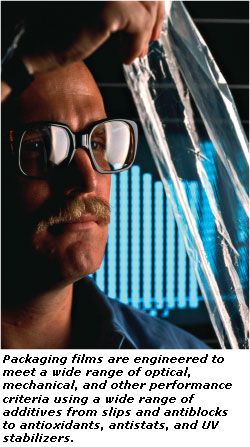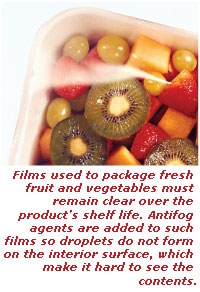Adding Up Additives
- Published: January 01, 2007, By By Mark McManus, Shawn Lucas, and Brian McKinley Ampacet Corp.
Film Additives
Most packaging films contain a complex mix of additives. Some of these enable films to process well during extrusion and converting. Others enhance package performance and help films display and protect products. They also perform such actions as limiting condensation, holding static in check, or screening out the ultraviolet (UV) radiation present in sunlight.
To do your job well, you need to understand how additives act in packaging films and how they affect your operations. Here is a look at the functional additives commonly found in packaging films—such as slips, antiblocks, and antioxidants—that make films easier to process, as well as antistats, UV stabilizers, and antifogs that help packaging do its job.
Keeping Friction in Bounds
Slips let films slide over themselves and move smoothly through converting equipment. When added to a film, they migrate to its surface and reduce coefficient of friction (COF). This large class of additives extends from traditional primary amide slips to specialty grades used at elevated temperatures or to hold COF constant before and after adhesive lamination.
Film COF at any one time depends on many factors, especially the rate of slip migration. Oleamide grades are primary slips that bloom rapidly to the surface. They are used during in-line forming and converting when COF must develop quickly. Slower-blooming slips, or erucamide slips, are needed in rollstock that will be converted days or weeks after a film is extruded. This slow rate of migration prevents COF from developing too rapidly and prevents winding difficulties and telescoping.
The amount of slip added also is important. If too little is used, films can tangle and wrinkle during converting. If slip level is too high, excess slip often appears as a white powder and sometimes as an oily liquid trapped between film layers. It then can interfere with film separation (so-called “wet blocking”), and if film is printed, can result in poor print quality.

Minimizing Adhesion
Blocking occurs when adjacent film layers adhere to each other after being pressed together, as can occur on a take-up roll or when film is stacked after converting. This issue, which often occurs with polyethylene and polypropylene films, is resolved by adding inorganic and organic antiblock additives.
Inorganic antiblocks contain fine mineral particles, often diatomaceous earth, talc, or calcium carbonate, which roughen a film’s surface microscopically and so reduce film-to-film contact. These antiblocks are relatively low in cost and typically are found in large-volume applications. While inorganic or mineral antiblocks increase film haze, a new high-clarity antiblock recently has been developed that actually raises film clarity and gloss well above that of the base resin.
Organic antiblocks cost more than inorganic ones but do not increase haze. They usually are used in higher-value, high-clarity films. Organic antiblocks are similar to slips in that they migrate to the surface of a film.
Converters that encounter blocking difficulties should check how tightly film layers are pressed together during winding and other steps, as well as with the film producer to ensure enough antiblock is present. An overdose of mineral antiblocks affects film gloss and haze but not converting. An organic antiblock overdose can cause oily or greasy deposits and wet blocking.
Reduced Oxidation
Antioxidants for packaging films fall into two categories: primary and secondary. Primary antioxidants stabilize films so they do not oxidize during protracted storage at converters’ facilities or during warehousing or display in retail settings. Such degradation can cause odors or film discoloration. Secondary antioxidants stabilize a polymer as it undergoes multiple heat histories.

They allow filmmakers to increase the amount of scrap used without generating more gels, black specks, and other imperfections.
Antioxidants are used more frequently in cast and blown films than in extrusion coating, because they can hinder adhesion to substrates. Primary antioxidants that contain phenolic compounds can cause film to yellow due to over-oxidation, pigment interaction, and other factors. Special non-phenol grades can be used to avoid such discoloration. If too much primary or secondary antioxidant is added to a film, it will migrate to the surface and often appear as a white powder.
Dissipating Static Charge
Antistatic additives prevent electrical charge from building on a film surface to such a degree that static discharge (sparking) occurs. These additives act by migrating to a film’s surface and drawing in moisture from the air. This moisture allows the charge to spread across the surface.
Antistats offer converters many benefits. In dissipating local surface charge, they make polyolefin and other films easier to handle. As a result, film sheets are less prone to stick together due to static electricity during die-cutting. Antistats also improve safety by reducing electrical discharge as films move over metal surfaces in converting equipment—especially in dry winter months—and as film is wound or unwound.
These additives reduce how much dust a package attracts, so it looks better on the shelf. They also forestall discharge where sparking is a hazard or can damage a product, e.g., in packaging for explosives, electronics, medical devices, and photographic film. As with slips, the presence of too much antistat additive can cause wet blocking between film layers.
Protection from UV
UV radiation in sunlight can degrade the packaging film itself and also can harm products in a package. To solve these problems, UV absorbers (UVAs) are added to protect the contents of a package, while UV inhibitors (UVIs) are added to stabilize the polymer if it is attacked by UV radiation. The latter maintain the integrity of bags stored or displayed outdoors, such as those for mulch, topsoil, or water-softening salt. The selection of additives to provide UV protection is complex and requires specialized knowledge of those available in relation to the end use and converting operations involved.
Some UVAs and UVIs are migratory and, if overdosed, can cause sealing problems. Converters should be aware that additives offering UV protection are alkaline and can react with acidic products, such as wood chips, which then would make packaging more vulnerable to the effects of sunlight.
Limiting Condensation
Antifog additives change a film’s surface tension so moisture condensing on the film spreads out as a thin layer rather than as droplets. This keeps the film transparent. Antifogs typically are added to films that package fresh produce and meats. Some antifog additive is washed away by the water that condenses on the film. Filmmakers add enough of this additive to replenish the antifog lost from the film surface during a package’s expected shelf life (usually 28 days or less). If too much antifog is present, it can accumulate on the surface and affect converting operations.

Packaging films are formulated to balance many factors, such as how a package will be used, film characteristics, other present additives, and regulatory concerns. They could not possibly perform well without the proper use of slips, organic antiblocks, UV inhibitors, antifogs, antistats, antioxidants, and other additives.
But converting problems can arise if too much or too little of an additive is present. This is especially true of migratory organic additives that act at the film surface. Overdosing such additives causes them to accumulate on the film, resulting in such problems as wet blocking and perhaps poor lamination, printing, and sealing.
Overdosing also can cause organic additives to deposit rapidly on rollers, cutting knives, and other equipment surfaces. These issues can be corrected by working with film producers to select the proper additive combinations and the proper dosage of each additive.
SUPPLIER INFO:
Ampacet Corp.—PFFC-ASAP 315. ampacet.com
Mark McManus is senior engineer for technical service–development at Ampacet, specializing in flexible packaging and chemical foaming agents. He joined the company in 1971 and has held such positions as color laboratory manager and plant technical superintendent. He has been involved in product development, technical service, and other R&D functions for the past 16 years.
Shawn Lucas is manager, analytical services, at Ampacet’s R&D center in Terre Haute, IN. In that capacity, he also serves as technical liaison for many customers. Before joining Ampacet in 1994, he headed analytical services for a films company and was a bench chemist. He has a B.S. in chemistry, an M.S. in analytical chemistry, and an MBA.
Brian McKinley joined Ampacet as strategic business manager of the company’s films unit in 2003. Previously he was with Honeywell as sales manager and global market manager for packaging and with Ticona as manager of new business development. He has a B.S. in finance from Valparaiso Univ. and an MBA in marketing from Fairleigh Dickenson Univ.
The views and opinions expressed in Technical Reports are those of the author(s), not those of the editors of PFFC. Please address comments to author(s).




